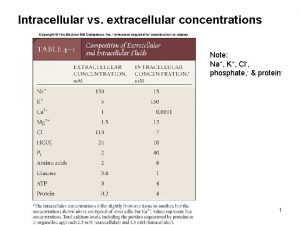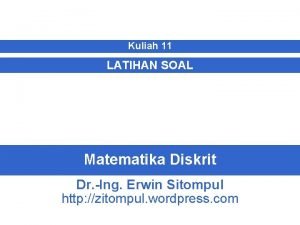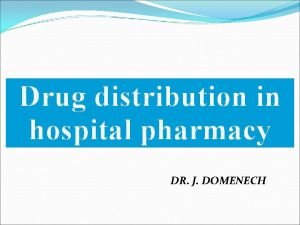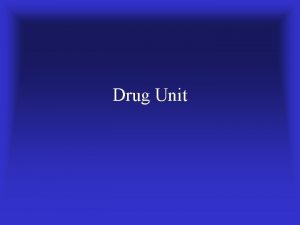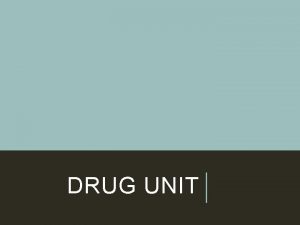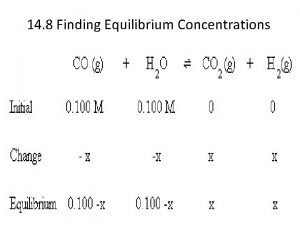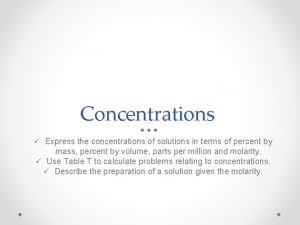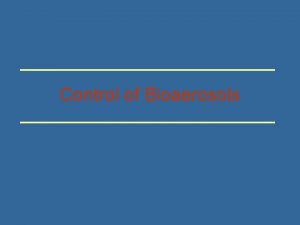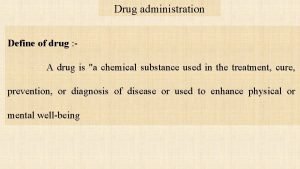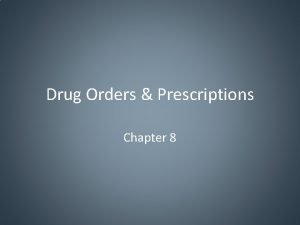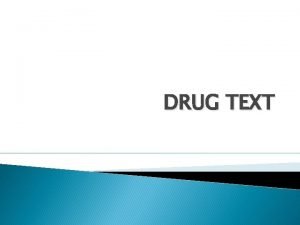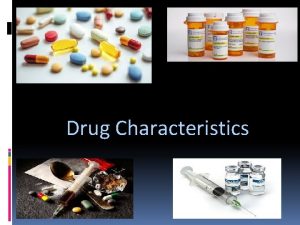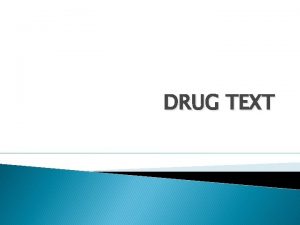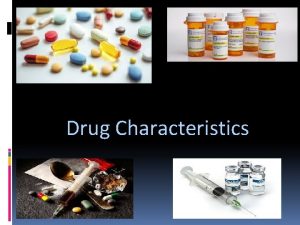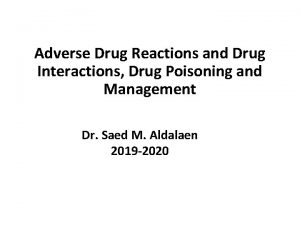Mathematics Unit 33 Drug Concentrations QUESTION 33 1















- Slides: 15

Mathematics Unit 33: Drug Concentrations QUESTION 33. 1 A woman in hospital receives an injection of penicillin. Her body gradually breaks the penicillin down so that one hour after the injection only 60% of the penicillin will remain active. This pattern continues: at the end of each hour only 60% of the penicillin that was present at the end of the previous hour remains active. Suppose the woman is given a dose of 300 milligrams of penicillin at 8 o’clock in the morning. Complete this table showing the amount of penicillin that will remain active in the woman’s blood at intervals of one hour from 0800 until 1100 hours. What do we want to find out? What useful information do we know? What other mathematical techniques do we need to apply? What have we learned?

Mathematics Unit 33: Drug Concentrations QUESTION 33. 1 A woman in hospital receives an injection of penicillin. Her body gradually breaks the penicillin down so that one hour after the injection only 60% of the penicillin will remain active. This pattern continues: at the end of each hour only 60% of the penicillin that was present at the end of the previous hour remains active. What do we want to find out? What useful information do we know? What other mathematical techniques do we need to apply? What have we learned? Suppose the woman is given a dose of 300 milligrams of penicillin at 8 o’clock in the morning. Complete this table showing the amount of penicillin that will remain active in the woman’s blood at intervals of one hour from 0800 until 1100 hours. Back to start

Mathematics Unit 33: Drug Concentrations QUESTION 33. 1 A woman in hospital receives an injection of penicillin. Her body gradually breaks the penicillin down so that one hour after the injection only 60% of the penicillin will remain active. This pattern continues: at the end of each hour only 60% of the penicillin that was present at the end of the previous hour remains active. What do we want to find out? What useful information do we know? What other mathematical techniques do we need to apply? What have we learned? Suppose the woman is given a dose of 300 milligrams of penicillin at 8 o’clock in the morning. Complete this table showing the amount of penicillin that will remain active in the woman’s blood at intervals of one hour from 0800 until 1100 hours. Back to start

Mathematics Unit 33: Drug Concentrations QUESTION 33. 1 A woman in hospital receives an injection of penicillin. Her body gradually breaks the penicillin down so that one hour after the injection only 60% of the penicillin will remain active. This pattern continues: at the end of each hour only 60% of the penicillin that was present at the end of the previous hour remains active. What do we want to find out? What useful information do we know? What other mathematical techniques do we need to apply? What have we learned? Suppose the woman is given a dose of 300 milligrams of penicillin at 8 o’clock in the morning. Complete this table showing the amount of penicillin that will remain active in the woman’s blood at intervals of one hour from 0800 until 1100 hours. Back to start

Mathematics Unit 33: Drug Concentrations QUESTION 33. 1 A woman in hospital receives an injection of penicillin. Her body gradually breaks the penicillin down so that one hour after the injection only 60% of the penicillin will remain active. This pattern continues: at the end of each hour only 60% of the penicillin that was present at the end of the previous hour remains active. What do we want to find out? What useful information do we know? What other mathematical techniques do we need to apply? What have we learned? Suppose the woman is given a dose of 300 milligrams of penicillin at 8 o’clock in the morning. Complete this table showing the amount of penicillin that will remain active in the woman’s blood at intervals of one hour from 0800 until 1100 hours. Back to start

Mathematics Unit 33: Drug Concentrations QUESTION 33. 2 Peter has to take 80 mg of a drug to control his blood pressure. The following graph shows the initial amount of the drug, and the amount that remains active in Peter’s blood after one, two, three and four days. What do we want to find out? What useful information do we know? What other mathematical techniques do we need to apply? What have we learned? How much of the drug remains active at the end of the first day? A. 6 mg. B. 12 mg. C. 26 mg. D. 32 mg.

Mathematics Unit 33: Drug Concentrations QUESTION 33. 2 Peter has to take 80 mg of a drug to control his blood pressure. The following graph shows the initial amount of the drug, and the amount that remains active in Peter’s blood after one, two, three and four days. What do we want to find out? What useful information do we know? What other mathematical techniques do we need to apply? What have we learned? How much of the drug remains active at the end of the first day? A. 6 mg. B. 12 mg. C. 26 mg. D. 32 mg. Back to start

Mathematics Unit 33: Drug Concentrations QUESTION 33. 2 Peter has to take 80 mg of a drug to control his blood pressure. The following graph shows the initial amount of the drug, and the amount that remains active in Peter’s blood after one, two, three and four days. What do we want to find out? What useful information do we know? What other mathematical techniques do we need to apply? What have we learned? How much of the drug remains active at the end of the first day? A. 6 mg. B. 12 mg. C. 26 mg. D. 32 mg. Back to start

Mathematics Unit 33: Drug Concentrations QUESTION 33. 2 Peter has to take 80 mg of a drug to control his blood pressure. The following graph shows the initial amount of the drug, and the amount that remains active in Peter’s blood after one, two, three and four days. What do we want to find out? What useful information do we know? What other mathematical techniques do we need to apply? What have we learned? How much of the drug remains active at the end of the first day? A. 6 mg. B. 12 mg. C. 26 mg. D. 32 mg. Back to start

Mathematics Unit 33: Drug Concentrations QUESTION 33. 2 Peter has to take 80 mg of a drug to control his blood pressure. The following graph shows the initial amount of the drug, and the amount that remains active in Peter’s blood after one, two, three and four days. What do we want to find out? What useful information do we know? What other mathematical techniques do we need to apply? What have we learned? How much of the drug remains active at the end of the first day? A. 6 mg. B. 12 mg. C. 26 mg. D. 32 mg. Back to start

Mathematics Unit 33: Drug Concentrations What do we want to find out? What useful information do we know? What other mathematical techniques do we need to apply? QUESTION 33. 3 From the graph for the previous question it can be seen that each day, about the same proportion of the previous day’s drug remains active in Peter’s blood. At the end of each day which of the following is the approximate percentage of the previous day’s drug that remains active? A. 20%. B. 30%. C. 40%. D. 80%. What have we learned?

Mathematics Unit 33: Drug Concentrations What do we want to find out? What useful information do we know? What other mathematical techniques do we need to apply? QUESTION 33. 3 From the graph for the previous question it can be seen that each day, about the same proportion of the previous day’s drug remains active in Peter’s blood. At the end of each day which of the following is the approximate percentage of the previous day’s drug that remains active? A. 20%. B. 30%. C. 40%. D. 80%. What have we learned? Back to start

Mathematics Unit 33: Drug Concentrations What do we want to find out? What useful information do we know? What other mathematical techniques do we need to apply? QUESTION 33. 3 From the graph for the previous question it can be seen that each day, about the same proportion of the previous day’s drug remains active in Peter’s blood. At the end of each day which of the following is the approximate percentage of the previous day’s drug that remains active? A. 20%. B. 30%. C. 40%. D. 80%. What have we learned? Back to start

Mathematics Unit 33: Drug Concentrations What do we want to find out? What useful information do we know? What other mathematical techniques do we need to apply? QUESTION 33. 3 From the graph for the previous question it can be seen that each day, about the same proportion of the previous day’s drug remains active in Peter’s blood. At the end of each day which of the following is the approximate percentage of the previous day’s drug that remains active? A. 20%. B. 30%. C. 40%. D. 80%. What have we learned? Back to start

Mathematics Unit 33: Drug Concentrations What do we want to find out? What useful information do we know? What other mathematical techniques do we need to apply? QUESTION 33. 3 From the graph for the previous question it can be seen that each day, about the same proportion of the previous day’s drug remains active in Peter’s blood. At the end of each day which of the following is the approximate percentage of the previous day’s drug that remains active? A. 20%. B. 30%. C. 40%. D. 80%. What have we learned? Back to start
 Intracellular vs extracellular ion concentrations
Intracellular vs extracellular ion concentrations Costa level questions examples
Costa level questions examples Different methods of adulteration of crude drugs
Different methods of adulteration of crude drugs Soal matematika kuliah semester 6
Soal matematika kuliah semester 6 Grade 12 financial maths
Grade 12 financial maths Unit 6 review questions
Unit 6 review questions Hospital pharmacy generally located at
Hospital pharmacy generally located at Unit dose drug distribution system flowchart
Unit dose drug distribution system flowchart Questions without question words
Questions without question words Nudging probe questions
Nudging probe questions Contoh remarks
Contoh remarks What is factor relating questions
What is factor relating questions Direct vs indirect question
Direct vs indirect question Example of supporting questions
Example of supporting questions Compelling vs supporting questions
Compelling vs supporting questions Grade 11 english unit 10
Grade 11 english unit 10
